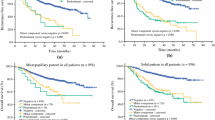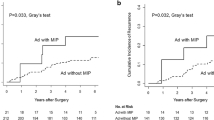Abstract
Objective
To investigate the PET/CT findings in lung invasive adenocarcinoma with minor components of micropapillary or solid contents and its association with lymph node metastasis.
Materials and methods
A total of 506 lung invasive adenocarcinoma (≤ 3 cm) patients who underwent a PET/CT examination and resection surgery were included. According to the proportion of solid/micropapillary components, the patients were classified into three groups: solid/micropapillary-negative (SMPN) (n = 258), solid/micropapillary-minor (SMPM; > 5% not predominant) (n = 158) and solid/micropapillary-predominant (SMPP; > 5% most dominant) (n = 90). The patients’ PET/CT findings, including SUVmax, MTV, TLG and CT characteristics, and other clinical factors were compared by one-way ANOVA test. Logistic regression analysis was done to identify the most predictive findings for lymph node metastasis.
Results
The value of SUVmax, MTV, TLG and tumor size was highest in SMPP group, followed by SMPM and SMPN group (P < 0.001).The areas under the curve for SUVmax, MTV and TLG for node metastasis were 0.822, 0.843 and 0.835, respectively. Univariate analysis found that the SMPP and SMPM group had more lymph node metastasis than the SMPN group (P < 0.001). Furthermore, the lymph node metastasis group had higher CEA, SUVmax, MTV, TLG, tumor size and more pleural invasion (P < 0.001). Logistic regression analysis found that SMPP pathological type, SMPM pathological type, higher CEA and male patients were risk factors for lymph node metastasis (P < 0.01).
Conclusions
Lung invasive adenocarcinoma with micropapillary or solid contents had higher SUVmax, MTV, TLG and tumor size and was associated with lymph node metastasis, even if they were not predominant.




Similar content being viewed by others
References
Travis WD, Brambilla E, Noguchi M, Nicholson AG, Geisinger KR, Yatabe Y, Beer DG, Powell CA, Riely GJ, Van Schil PE, Garg K, Austin JH, Asamura H, Rusch VW, Hirsch FR, Scagliotti G, Mitsudomi T, Huber RM, Ishikawa Y, Jett J, Sanchez-Cespedes M, Sculier JP, Takahashi T, Tsuboi M, Vansteenkiste J, Wistuba I, Yang PC, Aberle D, Brambilla C, Flieder D, Franklin W, Gazdar A, Gould M, Hasleton P, Henderson D, Johnson B, Johnson D, Kerr K, Kuriyama K, Lee JS, Miller VA, Petersen I, Roggli V, Rosell R, Saijo N, Thunnissen E, Tsao M, Yankelewitz D (2011) International association for the study of lung cancer/american thoracic society/european respiratory society international multidisciplinary classification of lung adenocarcinoma. J Thorac Oncol 6(2):244–285. https://doi.org/10.1097/JTO.0b013e318206a221
Warth A, Muley T, Meister M, Stenzinger A, Thomas M, Schirmacher P, Schnabel PA, Budczies J, Hoffmann H, Weichert W (2012) The novel histologic international association for the study of lung cancer/american thoracic society/european respiratory society classification system of lung adenocarcinoma is a stage-independent predictor of survival. J Clin Oncol 30(13):1438–1446. https://doi.org/10.1200/jco.2011.37.2185
Zhang Y, Wang R, Cai D, Li Y, Pan Y, Hu H, Wang L, Li H, Ye T, Luo X, Zhang Y, Li B, Shen L, Sun Y, Chen H (2014) A comprehensive investigation of molecular features and prognosis of lung adenocarcinoma with micropapillary component. J Thorac Oncol 9(12):1772–1778. https://doi.org/10.1097/jto.0000000000000341
Cha MJ, Lee HY, Lee KS, Jeong JY, Han J, Shim YM, Hwang HS (2014) Micropapillary and solid subtypes of invasive lung adenocarcinoma: clinical predictors of histopathology and outcome. J Thorac Cardiovasc Surg 147(3):921–928.e922. https://doi.org/10.1016/j.jtcvs.2013.09.045
Ujiie H, Kadota K, Chaft JE, Buitrago D, Sima CS, Lee MC, Huang J, Travis WD, Rizk NP, Rudin CM, Jones DR, Adusumilli PS (2015) Solid predominant histologic subtype in resected stage I lung adenocarcinoma is an independent predictor of early, extrathoracic, multisite recurrence and of poor postrecurrence survival. J Clin Oncol 33(26):2877–2884. https://doi.org/10.1200/jco.2015.60.9818
Xu L, Tavora F, Burke A (2013) Histologic features associated with metastatic potential in invasive adenocarcinomas of the lung. Am J Surg Pathol 37(7):1100–1108. https://doi.org/10.1097/PAS.0b013e31827fcf04
Park JK, Kim JJ, Moon SW, Lee KY (2017) Lymph node involvement according to lung adenocarcinoma subtypes: lymph node involvement is influenced by lung adenocarcinoma subtypes. J Thorac Dis 9(10):3903–3910. https://doi.org/10.21037/jtd.2017.08.132
Ye B, Cheng M, Li W, Ge XX, Geng JF, Feng J, Yang Y, Hu DZ (2014) Predictive factors for lymph node metastasis in clinical stage IA lung adenocarcinoma. Ann Thorac Surg 98(1):217–223. https://doi.org/10.1016/j.athoracsur.2014.03.005
Zhao Y, Wang R, Shen X, Pan Y, Cheng C, Li Y, Shen L, Zhang Y, Li H, Zheng D, Ye T, Zheng S, Sun Y, Chen H (2016) Minor components of micropapillary and solid subtypes in lung adenocarcinoma are predictors of lymph node metastasis and poor prognosis. Ann Surg Oncol 23(6):2099–2105. https://doi.org/10.1245/s10434-015-5043-9
Yanagawa N, Shiono S, Abiko M, Katahira M, Osakabe M, Ogata SY (2016) The clinical impact of solid and micropapillary patterns in resected lung adenocarcinoma. J Thorac Oncol 11(11):1976–1983
Zombori T, Nyári T, Tiszlavicz L, Pálföldi R, Csada E, Géczi T, Ottlakán A, Pécsy B, Cserni G, Furák J (2018) The more the micropapillary pattern in stage I lung adenocarcinoma, the worse the prognosis-a retrospective study on digitalized slides. Virchows Arch 472(6):949–958. https://doi.org/10.1007/s00428-018-2337-x
Qian F, Yang W, Wang R, Xu J, Wang S, Zhang Y, Jin B, Yu K, Han B (2018) Prognostic significance and adjuvant chemotherapy survival benefits of a solid or micropapillary pattern in patients with resected stage IB lung adenocarcinoma. J Thorac Cardiovasc Surg 155(3):1227–1235.e1222. https://doi.org/10.1016/j.jtcvs.2017.09.143
Lewis P, Griffin S, Marsden P, Gee T, Nunan T, Malsey M, Dussek J (1994) Whole-body 18F-fluorodeoxyglucose positron emission tomography in preoperative evaluation of lung cancer. Lancet (Lond, England) 344(8932):1265–1266
Nakamura H, Saji H, Shinmyo T, Tagaya R, Kurimoto N, Koizumi H, Takagi M (2015) Close association of IASLC/ATS/ERS lung adenocarcinoma subtypes with glucose-uptake in positron emission tomography. Lung Cancer (Amsterdam, Netherlands) 87(1):28–33. https://doi.org/10.1016/j.lungcan.2014.11.010
Suarez-Pinera M, Belda-Sanchis J, Taus A, Sanchez-Font A, Mestre-Fusco A, Jimenez M, Pijuan L (2018) FDG PET-CT SUVmax and IASLC/ATS/ERS histologic classification: a new profile of lung adenocarcinoma with prognostic value. Am J Nucl Med Mol Imaging 8(2):100–109
Li Q, Fan L, Li Q, Liu K, He Q, Liu S (2015) Predict lymph node status according to the solid size and maximum standardized uptake value of lung adenocarcinoma with a size of ≤ 3 cm. Chin J Radiol 5:340–343. https://doi.org/10.3760/cma.j.issn.1005-1201.2015.05.005
Zhao ZR, Xi SY, Li W, Situ DR, Chen KM, Yang H, Su XD, Lin YB, Long H (2015) Prognostic impact of pattern-based grading system by the new IASLC/ATS/ERS classification in Asian patients with stage I lung adenocarcinoma. Lung Cancer (Amsterdam, Netherlands) 90(3):604–609. https://doi.org/10.1016/j.lungcan.2015.10.026
Kim DH, Song BI, Hong CM, Jeong SY, Lee SW, Lee J, Ahn BC (2014) Metabolic parameters using (1)(8)F-FDG PET/CT correlate with occult lymph node metastasis in squamous cell lung carcinoma. Eur J Nucl Med Mol Imaging 41(11):2051–2057. https://doi.org/10.1007/s00259-014-2831-6
Park SY, Yoon JK, Park KJ, Lee SJ (2015) Prediction of occult lymph node metastasis using volume-based PET parameters in small-sized peripheral non-small cell lung cancer. Cancer Imag 15:21. https://doi.org/10.1186/s40644-015-0058-9
Yanagawa M, Kusumoto M, Johkoh T, Noguchi M, Minami Y, Sakai F, Asamura H, Tomiyama N (2018) Radiologic-pathologic correlation of solid portions on thin-section CT images in lung adenocarcinoma: a multicenter study. Clin Lung Cancer 19(3):e303–e312. https://doi.org/10.1016/j.cllc.2017.12.005
Miao Y, Zhang J, Zou J, Zhu Q, Lv T, Song Y (2017) Correlation in histological subtypes with high resolution computed tomography signatures of early stage lung adenocarcinoma. Transl Lung Cancer Res 6(1):14–22. https://doi.org/10.21037/tlcr.2017.02.06
Ko JP, Suh J, Ibidapo O, Escalon JG, Li J, Pass H, Naidich DP, Crawford B, Tsai EB, Koo CW, Mikheev A, Rusinek H (2016) Lung adenocarcinoma: correlation of quantitative CT findings with pathologic findings. Radiology 280(3):931–939. https://doi.org/10.1148/radiol.2016142975
Acknowledgements
This study was supported by the Natural Science Foundation of Shanghai (Grant Number 18ZR1435200); the National Natural Science Foundation of China (Grant Number 81602415); and the Scientific Research project of Shanghai Municipal Commission of Health and Family Planning (Grant Number 20174Y0077); the National Natural Science Foundation of China (Grant NUMBERS 81773007).
Author information
Authors and Affiliations
Corresponding authors
Ethics declarations
Conflict of interest
The authors declare that they have no conflict of interest.
Ethical approval
The institutional ethics review board approved this retrospective study and waived the need for informed consent.
Additional information
Publisher's Note
Springer Nature remains neutral with regard to jurisdictional claims in published maps and institutional affiliations.
Rights and permissions
About this article
Cite this article
Chang, C., Sun, X., Zhao, W. et al. Minor components of micropapillary and solid subtypes in lung invasive adenocarcinoma (≤ 3 cm): PET/CT findings and correlations with lymph node metastasis. Radiol med 125, 257–264 (2020). https://doi.org/10.1007/s11547-019-01112-x
Received:
Accepted:
Published:
Issue Date:
DOI: https://doi.org/10.1007/s11547-019-01112-x




